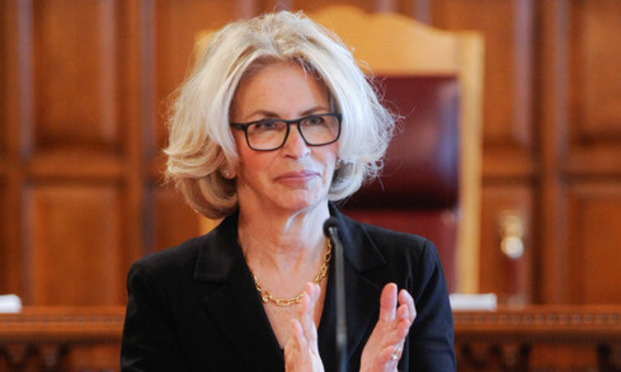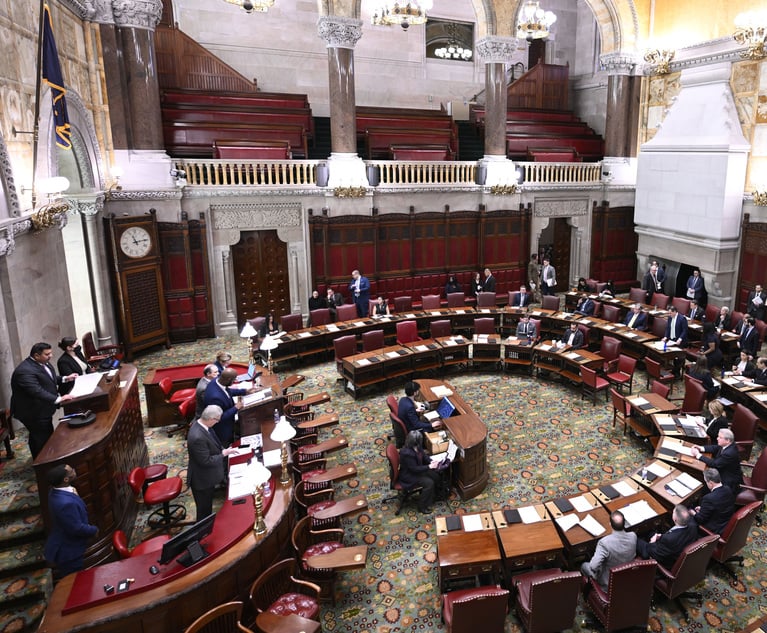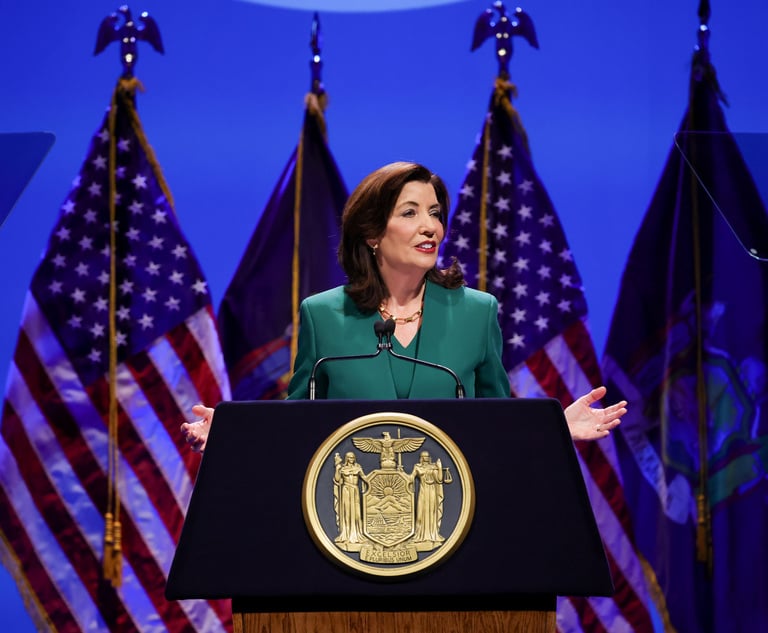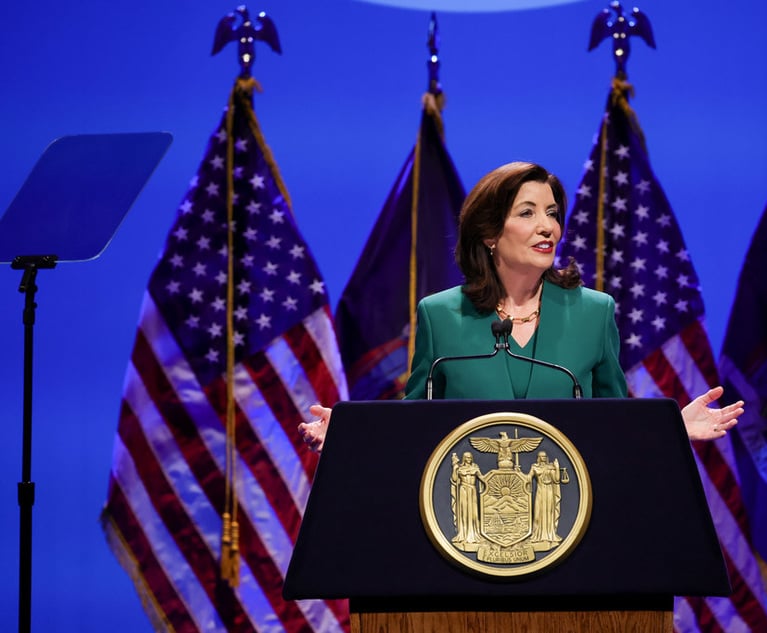NY Lawmakers Eye DiFiore's Court Reform Plan for Impact on Judicial Diversity
NYSBA president Hank Greenberg said DiFiore's plan would support diversity on the bench, agreeing with those who said more positions on the State Supreme Court, and a larger pool for eligible appellate judges, would work toward that goal.
November 13, 2019 at 04:51 PM
8 minute read
 New York Chief Judge Janet DiFiore. Photo: Tim Roske
New York Chief Judge Janet DiFiore. Photo: Tim Roske
New York lawmakers and judges on Wednesday appeared to be conflicted on whether Chief Judge Janet DiFiore's proposal to consolidate the number of trial courts would impede efforts to boost diversity on the bench, or if it might provide more opportunities to reach that goal.
That was one topic—among many—discussed Wednesday at the first public hearing held by the state Legislature on the issue of court reform in New York in at least two decades.
Chief Administrative Judge Lawrence Marks, who testified as a surrogate for DiFiore in support of the plan, insisted that the new system would create a more diverse judiciary.
"It's almost a truism that our proposal will lead to more diversity on the [State] Supreme Court bench in upstate jurisdictions," Marks said.
That's because, Marks said, positions that are more likely to be held by judges of color would be folded into the state Supreme Court under the plan. That means the share of judgeships held by persons of color on the state Supreme Court would likely increase, Marks said.
That's not the case under the state's current structure of trial courts, where state Supreme Court Justices are elected by voters from several counties for one spot on the bench. That makes it more difficult for people of color to be elected to those positions in rural areas, Marks said.
But under DiFiore's plan, that election scheme would change for a share of positions on the state Supreme Court.
The plan would consolidate the state's current structure of 11 different trial courts into just three sections: the State Supreme Court, a Municipal Court and the town and village courts.
The state Supreme Court would be formed by eliminating many of the state's current trial courts and folding them into a unified entity. The state Court of Claims, County Courts, Family Courts and Surrogate's Courts would all be nixed under the plan.
While the title of those judges would change, the way they're selected would not under the proposal. Positions previously held in the Family Court outside New York City, for example, would still be elected by voters in each county.
That means that some judges on the state Supreme Court, under the plan, would be elected by voters from several counties, while others would be chosen by residents of just one county. Judges previously on the Court of Claims would continue to be appointed by the governor.
Marks said Wednesday that judges of color are more likely to be elected upstate when they're chosen by residents of just one county, like those who currently sit on the Family Court or County Court. That's more common in counties with larger cities.
So, Marks said, with positions more likely to be held by persons of color folded into the state Supreme Court, the bench is bound to become more diverse. That would also widen the pool of diverse judges that could be appointed to the state's appellate courts, he said.
"Making the county-level judges—the Family Court judges, the Surrogate's Court judges and the county judges—Supreme Court Justices … would provide more judges of color on the Supreme Court and allow the governor a wider group of judges to pick from to make more diverse appointments to the Appellate Division," Marks said.
State Sen. Brad Hoylman, D-Manhattan, who chairs the Senate Judiciary Committee, echoed that argument later in the hearing during testimony from Chief Judge Jonathan Lippman and former Associate Judge Carmen Beauchamp Ciparick of the New York Court of Appeals.
"The fundamental issue of selecting judges is not changed," Hoylman said. "What we're doing is increasing the pool among the eligible judges for the Appellate Division with a broader Supreme Court pool that will include Court of Claims judges which have not been diverse, but also other judges, that have been diverse."
Ciparick, who was the first Hispanic woman to sit on the Court of Appeals, said she also saw the proposal as an opportunity to widen the pool for possible appointees to the state's higher courts.
"I see that as an increase in numbers from which an appointing authority can select future members of the Appellate Division," Ciparick said.
State Sen. Luis Sepulveda, D-Bronx, viewed the result of the proposal from a different angle. Sepulveda, who chairs the Senate Correction Committee, also leads a subcommittee on judicial diversity in the Senate.
He argued that, while the number of people of color on the state Supreme Court may increase, the share of those individuals would shrink given the number of white judges that would also be added to the pool. The Court of Claims, for example, is composed predominantly of white jurists.
"If you ask me, it may be diluting the impact of the ability of someone, an African American or Latino, to become a judge in those upstate appellate courts because now you've essentially put everyone in one big basket," Sepulveda said.
Assemblyman Jeffrey Dinowitz, D-Bronx, who chairs the Assembly Judiciary Committee, also appeared hesitant to endorse the idea that DiFiore's plan would enhance diversity in the state's courts.
He said judicial positions that are currently appointed, rather than elected, are currently less likely to be held by persons of color. That trend wouldn't change under DiFiore's proposal, he said, even though the titles of those individuals would.
Dinowitz agreed that there's a lack of diversity on the bench, particularly in upstate New York, but said that can be partly attributed to which party is selecting those judges.
"I think we should be honest with ourselves and understand that it's a good part due to party, and which party is in control," Dinowitz said. "That's the reality."
Dinowitz said he was undecided on the DiFiore's plan and wanted to hear from all sides of the issue before he took a position on the proposal.
Among the stakeholders to testify in opposition to the plan Wednesday was Manhattan Supreme Court Justice Debra James, who appeared on behalf of the Supreme Court Justices Association of the City of New York.
She shared similar concerns about diversity, but also spoke against part of the proposal that would allow state court officials to shift judges to different assignments as they see fit.
Under current law, state court officials can not shift judges from the Court of Claims, Family Court, or state Supreme Court to a position on the Surrogate's Court, or vice versa. DiFiore's proposal would remove that limit, James said.
"In reality, the devil is in the proverbial details," James said.
Opponents of the proposal have claimed more extreme examples of that power, saying state court officials could move a judge from Syracuse, for example, to hear cases in New York City. Marks said that's possible, but would never be done involuntarily.
"Frankly, that's absurd," Marks said.
Hank Greenberg, the current president of the New York State Bar Association and a shareholder at Greenberg Traurig, testified that there was no evidence to back up such claims. The State Bar has long supported reforming the state's trial courts.
"Simply pointing out that a power can be abused is not an excuse to not give a power," Greenberg said.
Greenberg also said DiFiore's plan would support diversity on the bench, rather than hinder it. He sided with Marks and Hoylman, saying that more positions on the State Supreme Court, and a larger pool for eligible appellate judges, would work toward that goal.
"Say what you will, debate however much, Judge DiFiore's proposal will diversify the Supreme Court upstate, and there has been no other attempt to do so," Greenberg said.
The state Office of Court Administration is expected to release a report in the coming days on the projected cost of DiFiore's plan, Marks said. They've estimated a price tag of $13.1 million once it's fully implemented—less than 1% of the judiciary's current budget.
READ MORE:
DiFiore's Trial Court Restructuring Plan Draws Opposition From Justices' Group
NY Lawmakers Set to Hold First Hearing on DiFiore's Trial Court Reform Plan
DiFiore Unveils Detailed Proposal for Lawmakers to Overhaul New York's Trial Courts
NY Lawmakers See Court Reform, Assigned Counsel Rate Hike With Favor
DiFiore Renews Call for Lawmakers to Restructure NY Court System
This content has been archived. It is available through our partners, LexisNexis® and Bloomberg Law.
To view this content, please continue to their sites.
Not a Lexis Subscriber?
Subscribe Now
Not a Bloomberg Law Subscriber?
Subscribe Now
NOT FOR REPRINT
© 2025 ALM Global, LLC, All Rights Reserved. Request academic re-use from www.copyright.com. All other uses, submit a request to [email protected]. For more information visit Asset & Logo Licensing.
You Might Like
View All
Relaxing Penalties on Discovery Noncompliance Allows Criminal Cases to Get Decided on Merit
5 minute read
Bipartisan Lawmakers to Hochul Urge Greater Student Loan Forgiveness for Public-Interest Lawyers

'Playing the Clock'?: Hochul Says NY's Discovery Loophole Is to Blame for Wide Dismissal of Criminal Cases

So Who Won? Congestion Pricing Ruling Leaves Both Sides Claiming Victory, Attorneys Seeking Clarification
4 minute readLaw Firms Mentioned
Trending Stories
- 1New York-Based Skadden Team Joins White & Case Group in Mexico City for Citigroup Demerger
- 2No Two Wildfires Alike: Lawyers Take Different Legal Strategies in California
- 3Poop-Themed Dog Toy OK as Parody, but Still Tarnished Jack Daniel’s Brand, Court Says
- 4Meet the New President of NY's Association of Trial Court Jurists
- 5Lawyers' Phones Are Ringing: What Should Employers Do If ICE Raids Their Business?
Who Got The Work
J. Brugh Lower of Gibbons has entered an appearance for industrial equipment supplier Devco Corporation in a pending trademark infringement lawsuit. The suit, accusing the defendant of selling knock-off Graco products, was filed Dec. 18 in New Jersey District Court by Rivkin Radler on behalf of Graco Inc. and Graco Minnesota. The case, assigned to U.S. District Judge Zahid N. Quraishi, is 3:24-cv-11294, Graco Inc. et al v. Devco Corporation.
Who Got The Work
Rebecca Maller-Stein and Kent A. Yalowitz of Arnold & Porter Kaye Scholer have entered their appearances for Hanaco Venture Capital and its executives, Lior Prosor and David Frankel, in a pending securities lawsuit. The action, filed on Dec. 24 in New York Southern District Court by Zell, Aron & Co. on behalf of Goldeneye Advisors, accuses the defendants of negligently and fraudulently managing the plaintiff's $1 million investment. The case, assigned to U.S. District Judge Vernon S. Broderick, is 1:24-cv-09918, Goldeneye Advisors, LLC v. Hanaco Venture Capital, Ltd. et al.
Who Got The Work
Attorneys from A&O Shearman has stepped in as defense counsel for Toronto-Dominion Bank and other defendants in a pending securities class action. The suit, filed Dec. 11 in New York Southern District Court by Bleichmar Fonti & Auld, accuses the defendants of concealing the bank's 'pervasive' deficiencies in regards to its compliance with the Bank Secrecy Act and the quality of its anti-money laundering controls. The case, assigned to U.S. District Judge Arun Subramanian, is 1:24-cv-09445, Gonzalez v. The Toronto-Dominion Bank et al.
Who Got The Work
Crown Castle International, a Pennsylvania company providing shared communications infrastructure, has turned to Luke D. Wolf of Gordon Rees Scully Mansukhani to fend off a pending breach-of-contract lawsuit. The court action, filed Nov. 25 in Michigan Eastern District Court by Hooper Hathaway PC on behalf of The Town Residences LLC, accuses Crown Castle of failing to transfer approximately $30,000 in utility payments from T-Mobile in breach of a roof-top lease and assignment agreement. The case, assigned to U.S. District Judge Susan K. Declercq, is 2:24-cv-13131, The Town Residences LLC v. T-Mobile US, Inc. et al.
Who Got The Work
Wilfred P. Coronato and Daniel M. Schwartz of McCarter & English have stepped in as defense counsel to Electrolux Home Products Inc. in a pending product liability lawsuit. The court action, filed Nov. 26 in New York Eastern District Court by Poulos Lopiccolo PC and Nagel Rice LLP on behalf of David Stern, alleges that the defendant's refrigerators’ drawers and shelving repeatedly break and fall apart within months after purchase. The case, assigned to U.S. District Judge Joan M. Azrack, is 2:24-cv-08204, Stern v. Electrolux Home Products, Inc.
Featured Firms
Law Offices of Gary Martin Hays & Associates, P.C.
(470) 294-1674
Law Offices of Mark E. Salomone
(857) 444-6468
Smith & Hassler
(713) 739-1250






